Addressing Diabetes in the Inuit Community: A Nursing Report Analysis
VerifiedAdded on 2023/04/05
|6
|1813
|191
Report
AI Summary
This report provides an in-depth analysis of diabetes within the Inuit community in Canada, focusing on the application of community health nursing principles. It highlights the prevalence of diabetes in the Inuit population and emphasizes the unique cultural and historical context. The report discusses various community health concepts, including health awareness, general benefit, organizational objectives, long-term service provision, current knowledge, professional growth, documentation, and collaboration, and illustrates the role of the community health nurse in addressing diabetes. It details the process of assessment, planning, implementation, and evaluation of interventions, emphasizing the importance of establishing working relationships, assessing health needs, setting objectives, planning interventions, and evaluating outcomes. The report also stresses the importance of cultural sensitivity, collaboration with healthcare teams, and the use of evidence-based practices to improve diabetes management and promote health within the Inuit community. The conclusion emphasizes the crucial role of community health nurses in assessing health status, linking individuals to appropriate care, and helping the Inuit community meet their health and nursing requirements.
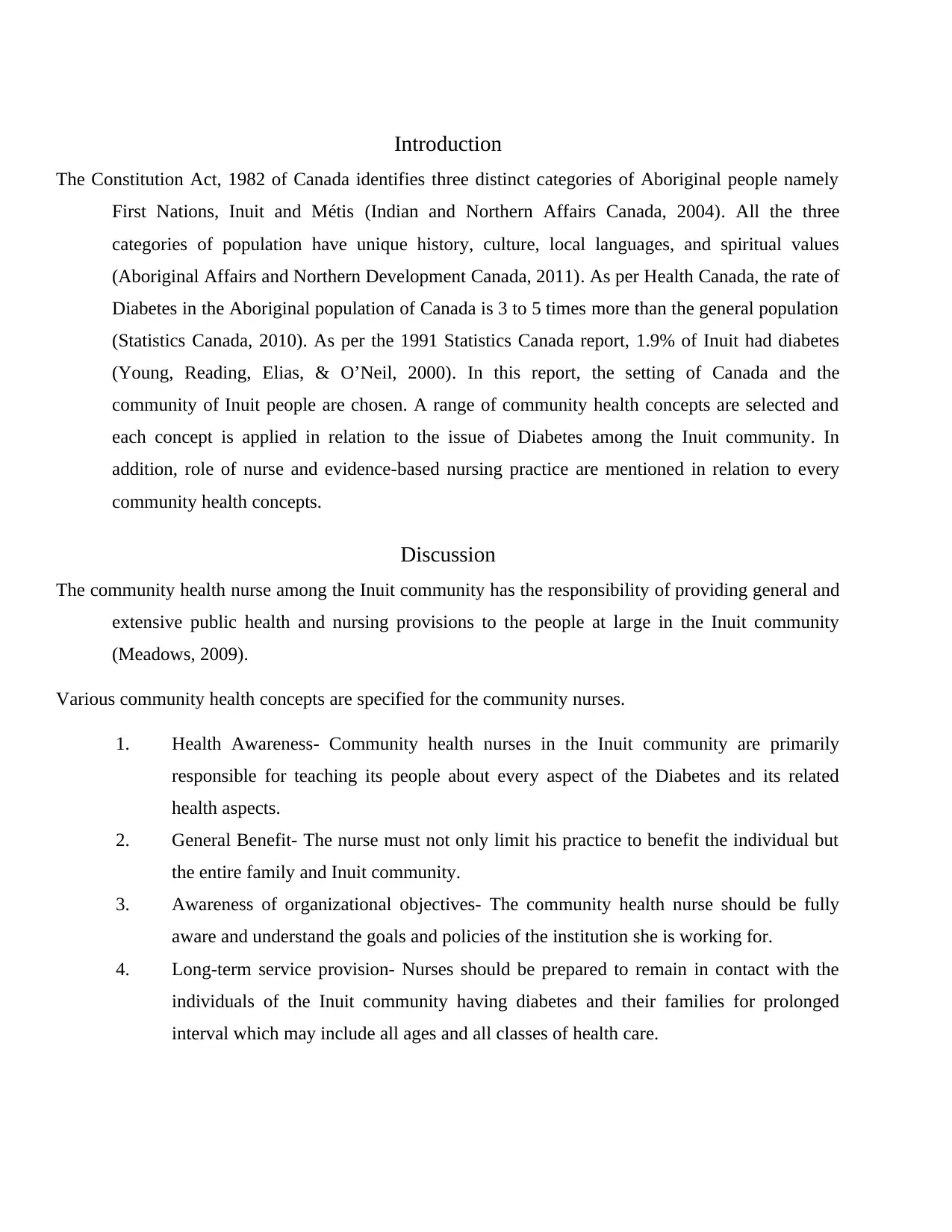
Introduction
The Constitution Act, 1982 of Canada identifies three distinct categories of Aboriginal people namely
First Nations, Inuit and Métis (Indian and Northern Affairs Canada, 2004). All the three
categories of population have unique history, culture, local languages, and spiritual values
(Aboriginal Affairs and Northern Development Canada, 2011). As per Health Canada, the rate of
Diabetes in the Aboriginal population of Canada is 3 to 5 times more than the general population
(Statistics Canada, 2010). As per the 1991 Statistics Canada report, 1.9% of Inuit had diabetes
(Young, Reading, Elias, & O’Neil, 2000). In this report, the setting of Canada and the
community of Inuit people are chosen. A range of community health concepts are selected and
each concept is applied in relation to the issue of Diabetes among the Inuit community. In
addition, role of nurse and evidence-based nursing practice are mentioned in relation to every
community health concepts.
Discussion
The community health nurse among the Inuit community has the responsibility of providing general and
extensive public health and nursing provisions to the people at large in the Inuit community
(Meadows, 2009).
Various community health concepts are specified for the community nurses.
1. Health Awareness- Community health nurses in the Inuit community are primarily
responsible for teaching its people about every aspect of the Diabetes and its related
health aspects.
2. General Benefit- The nurse must not only limit his practice to benefit the individual but
the entire family and Inuit community.
3. Awareness of organizational objectives- The community health nurse should be fully
aware and understand the goals and policies of the institution she is working for.
4. Long-term service provision- Nurses should be prepared to remain in contact with the
individuals of the Inuit community having diabetes and their families for prolonged
interval which may include all ages and all classes of health care.
The Constitution Act, 1982 of Canada identifies three distinct categories of Aboriginal people namely
First Nations, Inuit and Métis (Indian and Northern Affairs Canada, 2004). All the three
categories of population have unique history, culture, local languages, and spiritual values
(Aboriginal Affairs and Northern Development Canada, 2011). As per Health Canada, the rate of
Diabetes in the Aboriginal population of Canada is 3 to 5 times more than the general population
(Statistics Canada, 2010). As per the 1991 Statistics Canada report, 1.9% of Inuit had diabetes
(Young, Reading, Elias, & O’Neil, 2000). In this report, the setting of Canada and the
community of Inuit people are chosen. A range of community health concepts are selected and
each concept is applied in relation to the issue of Diabetes among the Inuit community. In
addition, role of nurse and evidence-based nursing practice are mentioned in relation to every
community health concepts.
Discussion
The community health nurse among the Inuit community has the responsibility of providing general and
extensive public health and nursing provisions to the people at large in the Inuit community
(Meadows, 2009).
Various community health concepts are specified for the community nurses.
1. Health Awareness- Community health nurses in the Inuit community are primarily
responsible for teaching its people about every aspect of the Diabetes and its related
health aspects.
2. General Benefit- The nurse must not only limit his practice to benefit the individual but
the entire family and Inuit community.
3. Awareness of organizational objectives- The community health nurse should be fully
aware and understand the goals and policies of the institution she is working for.
4. Long-term service provision- Nurses should be prepared to remain in contact with the
individuals of the Inuit community having diabetes and their families for prolonged
interval which may include all ages and all classes of health care.
Paraphrase This Document
Need a fresh take? Get an instant paraphrase of this document with our AI Paraphraser
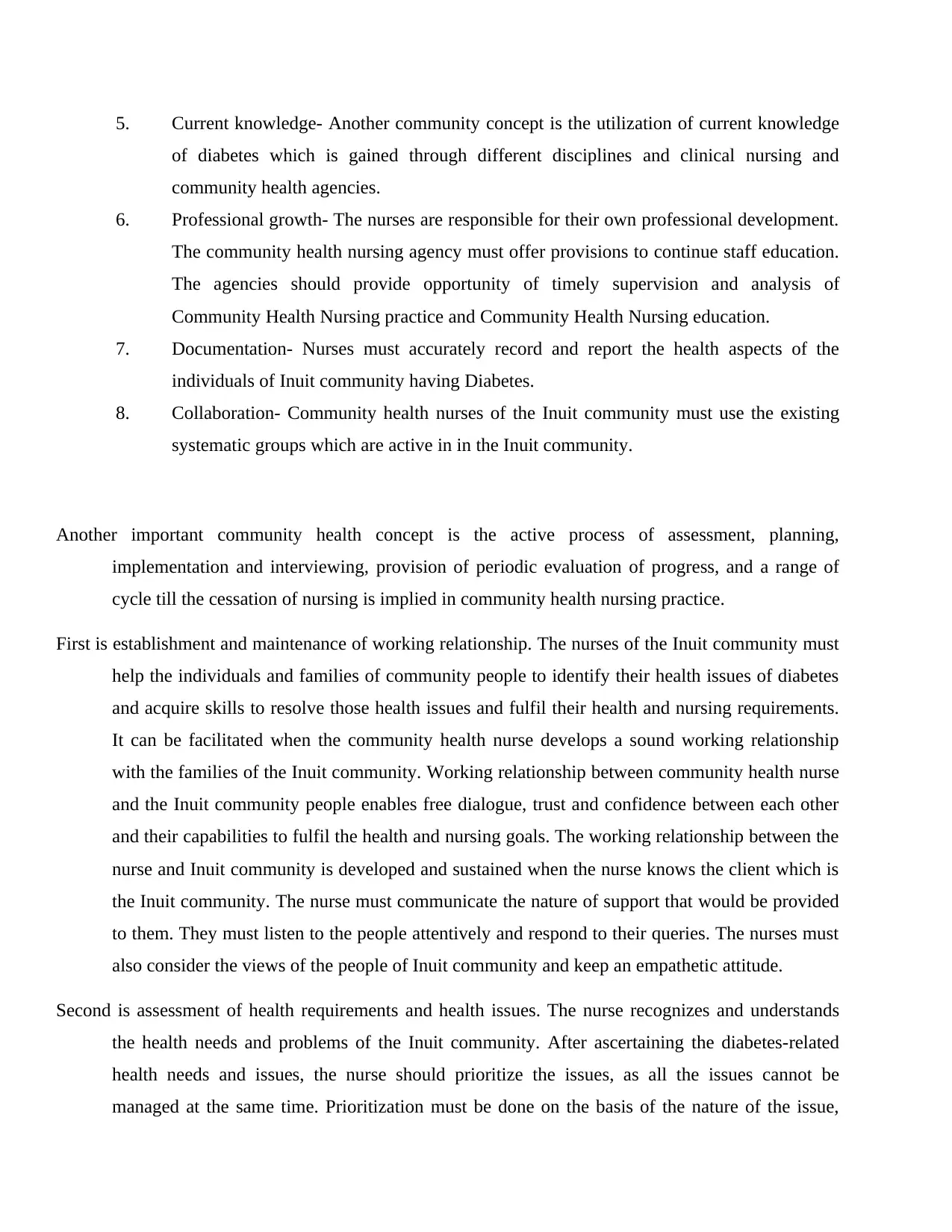
5. Current knowledge- Another community concept is the utilization of current knowledge
of diabetes which is gained through different disciplines and clinical nursing and
community health agencies.
6. Professional growth- The nurses are responsible for their own professional development.
The community health nursing agency must offer provisions to continue staff education.
The agencies should provide opportunity of timely supervision and analysis of
Community Health Nursing practice and Community Health Nursing education.
7. Documentation- Nurses must accurately record and report the health aspects of the
individuals of Inuit community having Diabetes.
8. Collaboration- Community health nurses of the Inuit community must use the existing
systematic groups which are active in in the Inuit community.
Another important community health concept is the active process of assessment, planning,
implementation and interviewing, provision of periodic evaluation of progress, and a range of
cycle till the cessation of nursing is implied in community health nursing practice.
First is establishment and maintenance of working relationship. The nurses of the Inuit community must
help the individuals and families of community people to identify their health issues of diabetes
and acquire skills to resolve those health issues and fulfil their health and nursing requirements.
It can be facilitated when the community health nurse develops a sound working relationship
with the families of the Inuit community. Working relationship between community health nurse
and the Inuit community people enables free dialogue, trust and confidence between each other
and their capabilities to fulfil the health and nursing goals. The working relationship between the
nurse and Inuit community is developed and sustained when the nurse knows the client which is
the Inuit community. The nurse must communicate the nature of support that would be provided
to them. They must listen to the people attentively and respond to their queries. The nurses must
also consider the views of the people of Inuit community and keep an empathetic attitude.
Second is assessment of health requirements and health issues. The nurse recognizes and understands
the health needs and problems of the Inuit community. After ascertaining the diabetes-related
health needs and issues, the nurse should prioritize the issues, as all the issues cannot be
managed at the same time. Prioritization must be done on the basis of the nature of the issue,
of diabetes which is gained through different disciplines and clinical nursing and
community health agencies.
6. Professional growth- The nurses are responsible for their own professional development.
The community health nursing agency must offer provisions to continue staff education.
The agencies should provide opportunity of timely supervision and analysis of
Community Health Nursing practice and Community Health Nursing education.
7. Documentation- Nurses must accurately record and report the health aspects of the
individuals of Inuit community having Diabetes.
8. Collaboration- Community health nurses of the Inuit community must use the existing
systematic groups which are active in in the Inuit community.
Another important community health concept is the active process of assessment, planning,
implementation and interviewing, provision of periodic evaluation of progress, and a range of
cycle till the cessation of nursing is implied in community health nursing practice.
First is establishment and maintenance of working relationship. The nurses of the Inuit community must
help the individuals and families of community people to identify their health issues of diabetes
and acquire skills to resolve those health issues and fulfil their health and nursing requirements.
It can be facilitated when the community health nurse develops a sound working relationship
with the families of the Inuit community. Working relationship between community health nurse
and the Inuit community people enables free dialogue, trust and confidence between each other
and their capabilities to fulfil the health and nursing goals. The working relationship between the
nurse and Inuit community is developed and sustained when the nurse knows the client which is
the Inuit community. The nurse must communicate the nature of support that would be provided
to them. They must listen to the people attentively and respond to their queries. The nurses must
also consider the views of the people of Inuit community and keep an empathetic attitude.
Second is assessment of health requirements and health issues. The nurse recognizes and understands
the health needs and problems of the Inuit community. After ascertaining the diabetes-related
health needs and issues, the nurse should prioritize the issues, as all the issues cannot be
managed at the same time. Prioritization must be done on the basis of the nature of the issue,
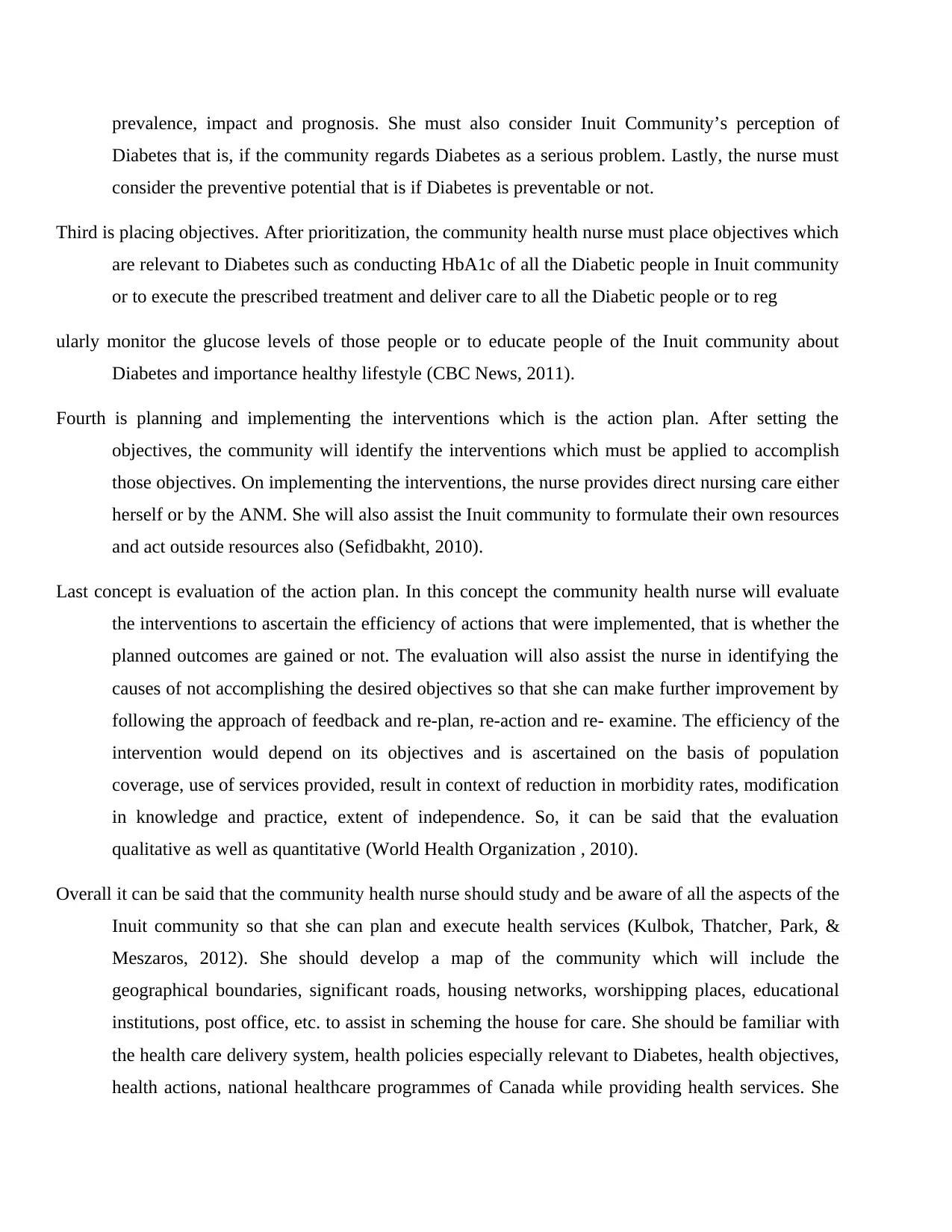
prevalence, impact and prognosis. She must also consider Inuit Community’s perception of
Diabetes that is, if the community regards Diabetes as a serious problem. Lastly, the nurse must
consider the preventive potential that is if Diabetes is preventable or not.
Third is placing objectives. After prioritization, the community health nurse must place objectives which
are relevant to Diabetes such as conducting HbA1c of all the Diabetic people in Inuit community
or to execute the prescribed treatment and deliver care to all the Diabetic people or to reg
ularly monitor the glucose levels of those people or to educate people of the Inuit community about
Diabetes and importance healthy lifestyle (CBC News, 2011).
Fourth is planning and implementing the interventions which is the action plan. After setting the
objectives, the community will identify the interventions which must be applied to accomplish
those objectives. On implementing the interventions, the nurse provides direct nursing care either
herself or by the ANM. She will also assist the Inuit community to formulate their own resources
and act outside resources also (Sefidbakht, 2010).
Last concept is evaluation of the action plan. In this concept the community health nurse will evaluate
the interventions to ascertain the efficiency of actions that were implemented, that is whether the
planned outcomes are gained or not. The evaluation will also assist the nurse in identifying the
causes of not accomplishing the desired objectives so that she can make further improvement by
following the approach of feedback and re-plan, re-action and re- examine. The efficiency of the
intervention would depend on its objectives and is ascertained on the basis of population
coverage, use of services provided, result in context of reduction in morbidity rates, modification
in knowledge and practice, extent of independence. So, it can be said that the evaluation
qualitative as well as quantitative (World Health Organization , 2010).
Overall it can be said that the community health nurse should study and be aware of all the aspects of the
Inuit community so that she can plan and execute health services (Kulbok, Thatcher, Park, &
Meszaros, 2012). She should develop a map of the community which will include the
geographical boundaries, significant roads, housing networks, worshipping places, educational
institutions, post office, etc. to assist in scheming the house for care. She should be familiar with
the health care delivery system, health policies especially relevant to Diabetes, health objectives,
health actions, national healthcare programmes of Canada while providing health services. She
Diabetes that is, if the community regards Diabetes as a serious problem. Lastly, the nurse must
consider the preventive potential that is if Diabetes is preventable or not.
Third is placing objectives. After prioritization, the community health nurse must place objectives which
are relevant to Diabetes such as conducting HbA1c of all the Diabetic people in Inuit community
or to execute the prescribed treatment and deliver care to all the Diabetic people or to reg
ularly monitor the glucose levels of those people or to educate people of the Inuit community about
Diabetes and importance healthy lifestyle (CBC News, 2011).
Fourth is planning and implementing the interventions which is the action plan. After setting the
objectives, the community will identify the interventions which must be applied to accomplish
those objectives. On implementing the interventions, the nurse provides direct nursing care either
herself or by the ANM. She will also assist the Inuit community to formulate their own resources
and act outside resources also (Sefidbakht, 2010).
Last concept is evaluation of the action plan. In this concept the community health nurse will evaluate
the interventions to ascertain the efficiency of actions that were implemented, that is whether the
planned outcomes are gained or not. The evaluation will also assist the nurse in identifying the
causes of not accomplishing the desired objectives so that she can make further improvement by
following the approach of feedback and re-plan, re-action and re- examine. The efficiency of the
intervention would depend on its objectives and is ascertained on the basis of population
coverage, use of services provided, result in context of reduction in morbidity rates, modification
in knowledge and practice, extent of independence. So, it can be said that the evaluation
qualitative as well as quantitative (World Health Organization , 2010).
Overall it can be said that the community health nurse should study and be aware of all the aspects of the
Inuit community so that she can plan and execute health services (Kulbok, Thatcher, Park, &
Meszaros, 2012). She should develop a map of the community which will include the
geographical boundaries, significant roads, housing networks, worshipping places, educational
institutions, post office, etc. to assist in scheming the house for care. She should be familiar with
the health care delivery system, health policies especially relevant to Diabetes, health objectives,
health actions, national healthcare programmes of Canada while providing health services. She
⊘ This is a preview!⊘
Do you want full access?
Subscribe today to unlock all pages.

Trusted by 1+ million students worldwide
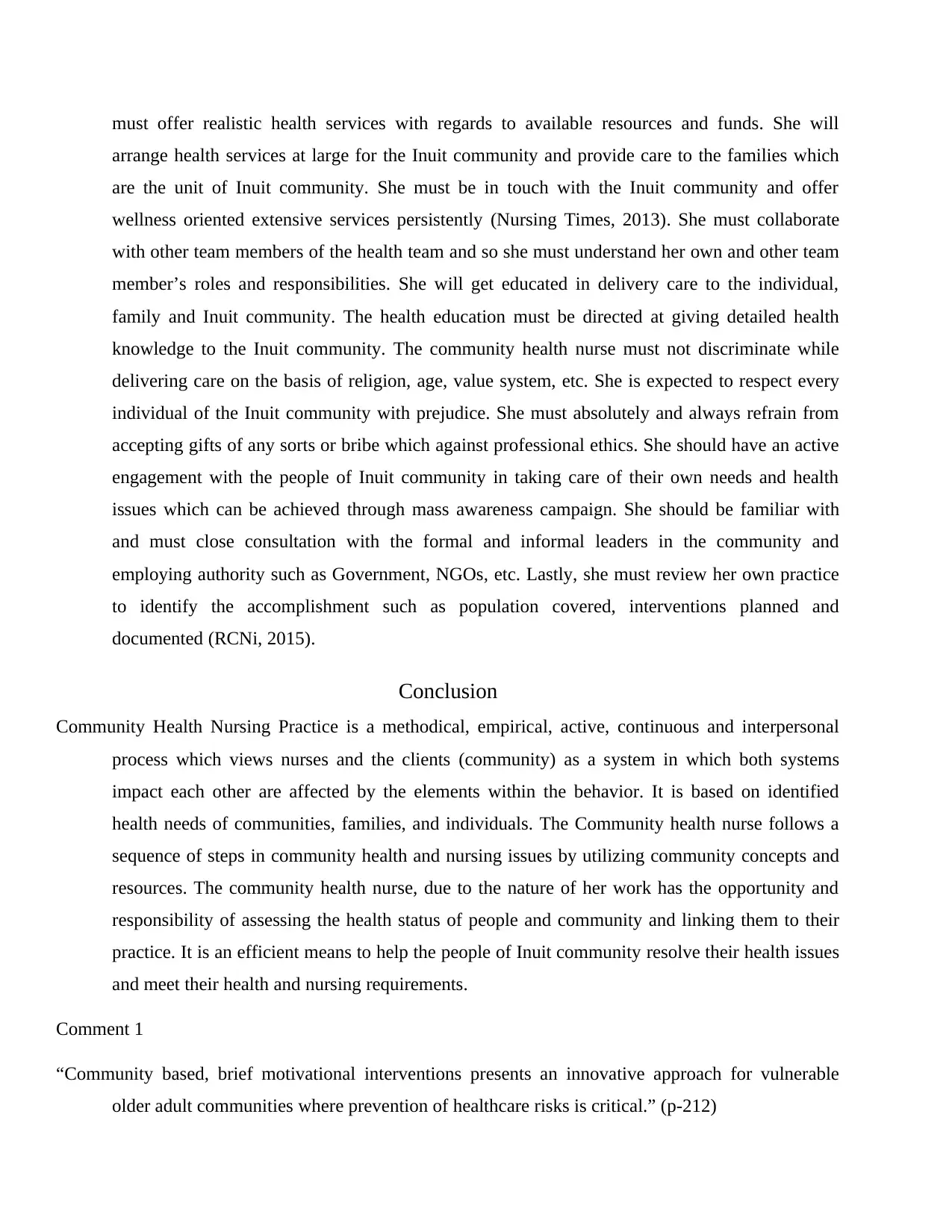
must offer realistic health services with regards to available resources and funds. She will
arrange health services at large for the Inuit community and provide care to the families which
are the unit of Inuit community. She must be in touch with the Inuit community and offer
wellness oriented extensive services persistently (Nursing Times, 2013). She must collaborate
with other team members of the health team and so she must understand her own and other team
member’s roles and responsibilities. She will get educated in delivery care to the individual,
family and Inuit community. The health education must be directed at giving detailed health
knowledge to the Inuit community. The community health nurse must not discriminate while
delivering care on the basis of religion, age, value system, etc. She is expected to respect every
individual of the Inuit community with prejudice. She must absolutely and always refrain from
accepting gifts of any sorts or bribe which against professional ethics. She should have an active
engagement with the people of Inuit community in taking care of their own needs and health
issues which can be achieved through mass awareness campaign. She should be familiar with
and must close consultation with the formal and informal leaders in the community and
employing authority such as Government, NGOs, etc. Lastly, she must review her own practice
to identify the accomplishment such as population covered, interventions planned and
documented (RCNi, 2015).
Conclusion
Community Health Nursing Practice is a methodical, empirical, active, continuous and interpersonal
process which views nurses and the clients (community) as a system in which both systems
impact each other are affected by the elements within the behavior. It is based on identified
health needs of communities, families, and individuals. The Community health nurse follows a
sequence of steps in community health and nursing issues by utilizing community concepts and
resources. The community health nurse, due to the nature of her work has the opportunity and
responsibility of assessing the health status of people and community and linking them to their
practice. It is an efficient means to help the people of Inuit community resolve their health issues
and meet their health and nursing requirements.
Comment 1
“Community based, brief motivational interventions presents an innovative approach for vulnerable
older adult communities where prevention of healthcare risks is critical.” (p-212)
arrange health services at large for the Inuit community and provide care to the families which
are the unit of Inuit community. She must be in touch with the Inuit community and offer
wellness oriented extensive services persistently (Nursing Times, 2013). She must collaborate
with other team members of the health team and so she must understand her own and other team
member’s roles and responsibilities. She will get educated in delivery care to the individual,
family and Inuit community. The health education must be directed at giving detailed health
knowledge to the Inuit community. The community health nurse must not discriminate while
delivering care on the basis of religion, age, value system, etc. She is expected to respect every
individual of the Inuit community with prejudice. She must absolutely and always refrain from
accepting gifts of any sorts or bribe which against professional ethics. She should have an active
engagement with the people of Inuit community in taking care of their own needs and health
issues which can be achieved through mass awareness campaign. She should be familiar with
and must close consultation with the formal and informal leaders in the community and
employing authority such as Government, NGOs, etc. Lastly, she must review her own practice
to identify the accomplishment such as population covered, interventions planned and
documented (RCNi, 2015).
Conclusion
Community Health Nursing Practice is a methodical, empirical, active, continuous and interpersonal
process which views nurses and the clients (community) as a system in which both systems
impact each other are affected by the elements within the behavior. It is based on identified
health needs of communities, families, and individuals. The Community health nurse follows a
sequence of steps in community health and nursing issues by utilizing community concepts and
resources. The community health nurse, due to the nature of her work has the opportunity and
responsibility of assessing the health status of people and community and linking them to their
practice. It is an efficient means to help the people of Inuit community resolve their health issues
and meet their health and nursing requirements.
Comment 1
“Community based, brief motivational interventions presents an innovative approach for vulnerable
older adult communities where prevention of healthcare risks is critical.” (p-212)
Paraphrase This Document
Need a fresh take? Get an instant paraphrase of this document with our AI Paraphraser
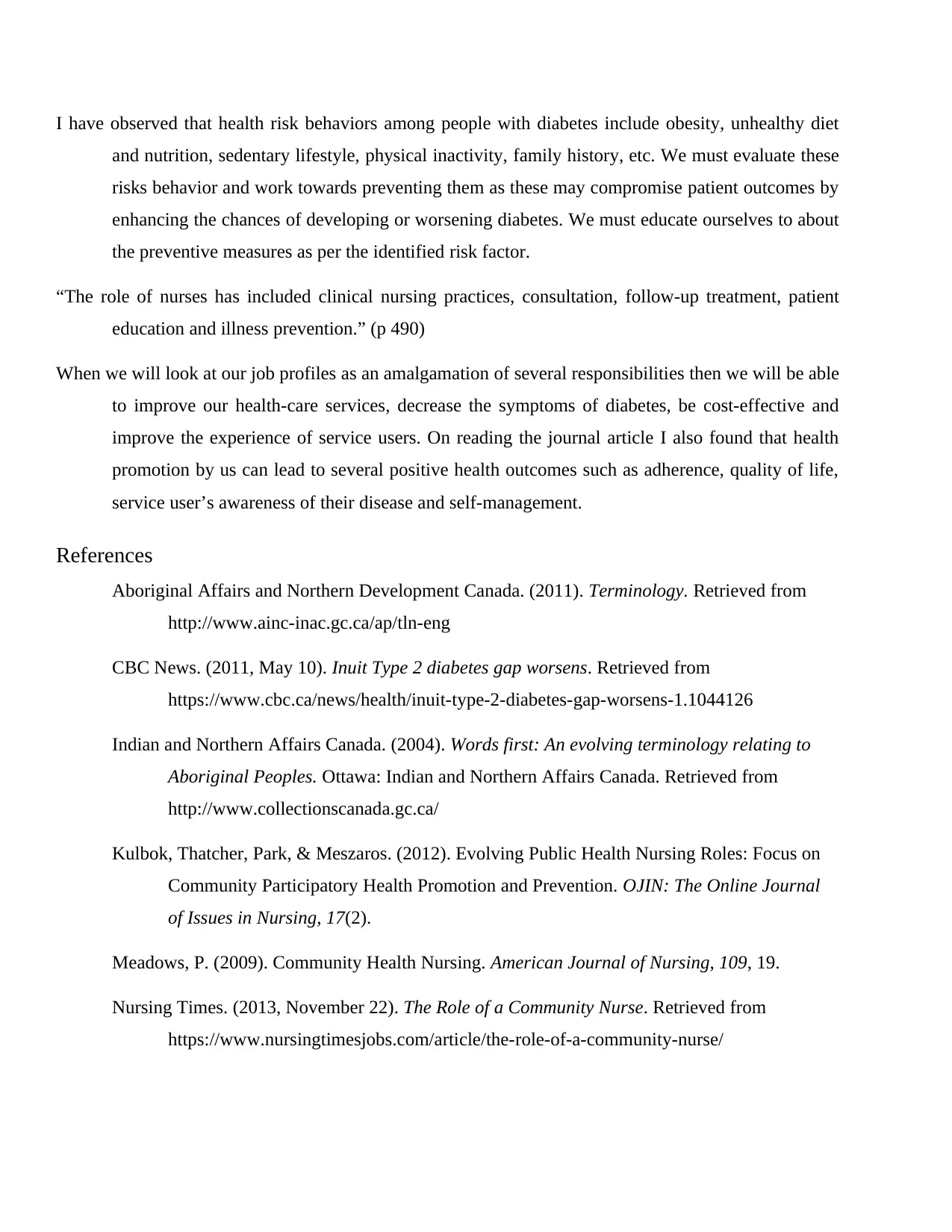
I have observed that health risk behaviors among people with diabetes include obesity, unhealthy diet
and nutrition, sedentary lifestyle, physical inactivity, family history, etc. We must evaluate these
risks behavior and work towards preventing them as these may compromise patient outcomes by
enhancing the chances of developing or worsening diabetes. We must educate ourselves to about
the preventive measures as per the identified risk factor.
“The role of nurses has included clinical nursing practices, consultation, follow-up treatment, patient
education and illness prevention.” (p 490)
When we will look at our job profiles as an amalgamation of several responsibilities then we will be able
to improve our health-care services, decrease the symptoms of diabetes, be cost-effective and
improve the experience of service users. On reading the journal article I also found that health
promotion by us can lead to several positive health outcomes such as adherence, quality of life,
service user’s awareness of their disease and self-management.
References
Aboriginal Affairs and Northern Development Canada. (2011). Terminology. Retrieved from
http://www.ainc-inac.gc.ca/ap/tln-eng
CBC News. (2011, May 10). Inuit Type 2 diabetes gap worsens. Retrieved from
https://www.cbc.ca/news/health/inuit-type-2-diabetes-gap-worsens-1.1044126
Indian and Northern Affairs Canada. (2004). Words first: An evolving terminology relating to
Aboriginal Peoples. Ottawa: Indian and Northern Affairs Canada. Retrieved from
http://www.collectionscanada.gc.ca/
Kulbok, Thatcher, Park, & Meszaros. (2012). Evolving Public Health Nursing Roles: Focus on
Community Participatory Health Promotion and Prevention. OJIN: The Online Journal
of Issues in Nursing, 17(2).
Meadows, P. (2009). Community Health Nursing. American Journal of Nursing, 109, 19.
Nursing Times. (2013, November 22). The Role of a Community Nurse. Retrieved from
https://www.nursingtimesjobs.com/article/the-role-of-a-community-nurse/
and nutrition, sedentary lifestyle, physical inactivity, family history, etc. We must evaluate these
risks behavior and work towards preventing them as these may compromise patient outcomes by
enhancing the chances of developing or worsening diabetes. We must educate ourselves to about
the preventive measures as per the identified risk factor.
“The role of nurses has included clinical nursing practices, consultation, follow-up treatment, patient
education and illness prevention.” (p 490)
When we will look at our job profiles as an amalgamation of several responsibilities then we will be able
to improve our health-care services, decrease the symptoms of diabetes, be cost-effective and
improve the experience of service users. On reading the journal article I also found that health
promotion by us can lead to several positive health outcomes such as adherence, quality of life,
service user’s awareness of their disease and self-management.
References
Aboriginal Affairs and Northern Development Canada. (2011). Terminology. Retrieved from
http://www.ainc-inac.gc.ca/ap/tln-eng
CBC News. (2011, May 10). Inuit Type 2 diabetes gap worsens. Retrieved from
https://www.cbc.ca/news/health/inuit-type-2-diabetes-gap-worsens-1.1044126
Indian and Northern Affairs Canada. (2004). Words first: An evolving terminology relating to
Aboriginal Peoples. Ottawa: Indian and Northern Affairs Canada. Retrieved from
http://www.collectionscanada.gc.ca/
Kulbok, Thatcher, Park, & Meszaros. (2012). Evolving Public Health Nursing Roles: Focus on
Community Participatory Health Promotion and Prevention. OJIN: The Online Journal
of Issues in Nursing, 17(2).
Meadows, P. (2009). Community Health Nursing. American Journal of Nursing, 109, 19.
Nursing Times. (2013, November 22). The Role of a Community Nurse. Retrieved from
https://www.nursingtimesjobs.com/article/the-role-of-a-community-nurse/
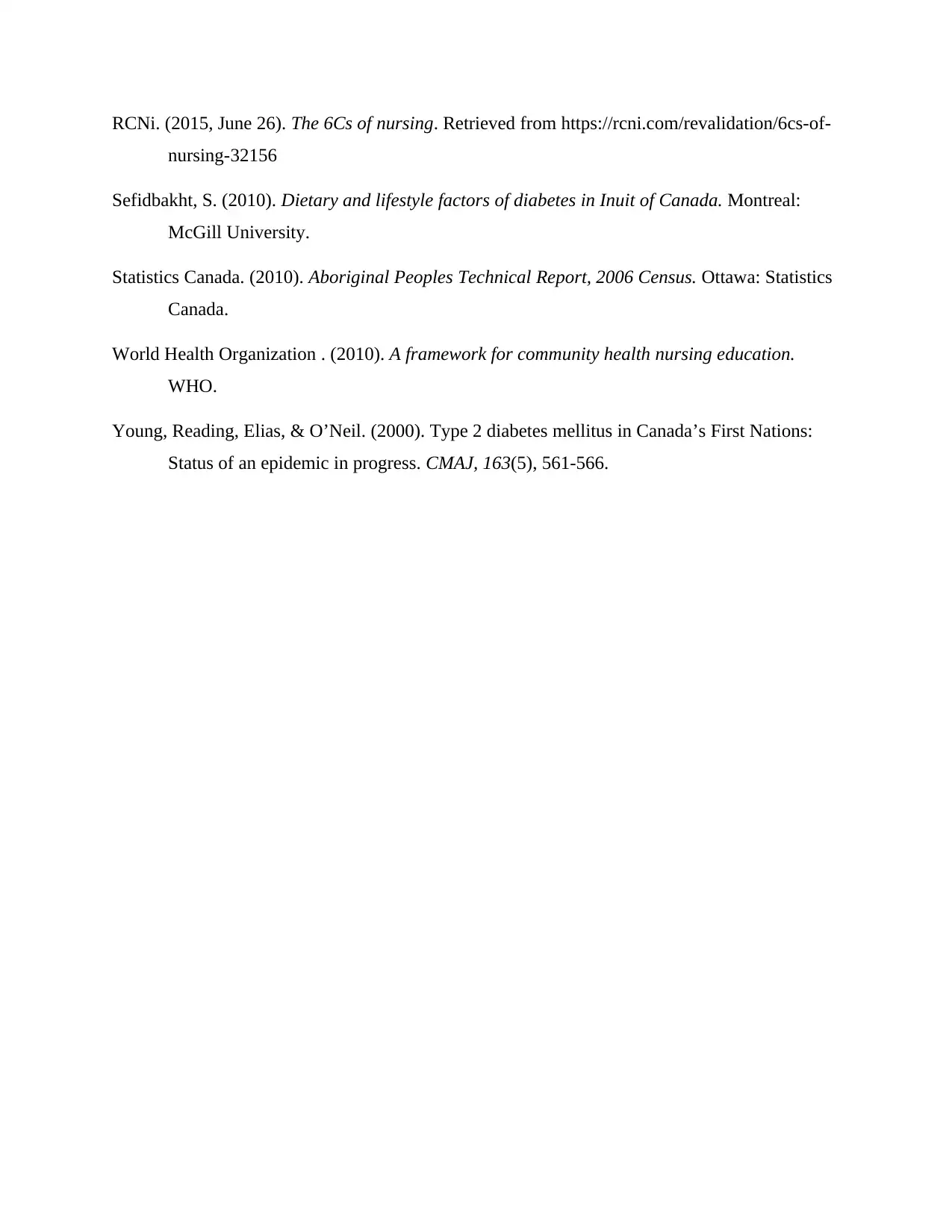
RCNi. (2015, June 26). The 6Cs of nursing. Retrieved from https://rcni.com/revalidation/6cs-of-
nursing-32156
Sefidbakht, S. (2010). Dietary and lifestyle factors of diabetes in Inuit of Canada. Montreal:
McGill University.
Statistics Canada. (2010). Aboriginal Peoples Technical Report, 2006 Census. Ottawa: Statistics
Canada.
World Health Organization . (2010). A framework for community health nursing education.
WHO.
Young, Reading, Elias, & O’Neil. (2000). Type 2 diabetes mellitus in Canada’s First Nations:
Status of an epidemic in progress. CMAJ, 163(5), 561-566.
nursing-32156
Sefidbakht, S. (2010). Dietary and lifestyle factors of diabetes in Inuit of Canada. Montreal:
McGill University.
Statistics Canada. (2010). Aboriginal Peoples Technical Report, 2006 Census. Ottawa: Statistics
Canada.
World Health Organization . (2010). A framework for community health nursing education.
WHO.
Young, Reading, Elias, & O’Neil. (2000). Type 2 diabetes mellitus in Canada’s First Nations:
Status of an epidemic in progress. CMAJ, 163(5), 561-566.
⊘ This is a preview!⊘
Do you want full access?
Subscribe today to unlock all pages.

Trusted by 1+ million students worldwide
1 out of 6
Related Documents
Your All-in-One AI-Powered Toolkit for Academic Success.
+13062052269
info@desklib.com
Available 24*7 on WhatsApp / Email
![[object Object]](/_next/static/media/star-bottom.7253800d.svg)
Unlock your academic potential
Copyright © 2020–2025 A2Z Services. All Rights Reserved. Developed and managed by ZUCOL.





